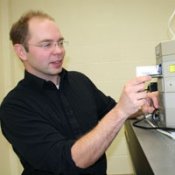
Biochemistry
Dr. Adam Hoppe - Associate Professor
Lab's Main Research Areas:
- Receptor signal transduction and membrane transport controlling the growth and differentiation of macrophages.
Recently, we have characterized the endocytic traffic of the Macrophage Colony Stimulating Factor-1 Receptor (CSF-1R), a primary growth factor for macrophages. Much of the signaling biochemistry of the CSF-1R has been worked out, owing to its prominent role of the CSF-1R in immunology, cancer and a variety of disease states. Our efforts have focused on defining how endocytosis and membrane transport of the CSF-1R modulate its signal transduction. Recently, we described a novel endocytic route for this receptor involving macropinosomes. - The function an underlying biochemical mechanisms of macropinocytosis in macrophages.
Macrophages and dendritic cells are highly adept at internalizing extracellular fluid and macromolecules by a process called macropinocytosis. Despite the prominent role of macropinocytosis in processes such as antigen uptake, little is know about the biochemical machinery regulating it. We are working to both elucidate these mechanisms as well as obtain a better understanding of the role of macropinosomes in cell growth. - Development of new methods for imaging biochemical events within living cells.
Studying biochemistry in living cells requires new ways to observe how and where molecules interact within cells. To this end, we continue to build upon our expertise in fluorescent protein tagging as well as the development of new strategies to use genome editing to create 'endogenously tagged' gene products. We then image these cells using a variety of techniques including Fluorescence Resonance Energy Transfer (FRET), to visualize protein-protein interactions. Total Internal Reflection Fluorescence (TIRF) to image interactions near the plasma membrane and polarized-TIRF to image membrane bending.
Educational Activities
My instructional activities are focused on the biochemistry activities in the department. Since my arrival in summer 2008, I developed a new undergraduate course in biophysical chemistry (CHEM 348) and associated lab (CHEM 348L), developed new material for graduate biochemistry (CHEM 662) as well as a new advanced graduate course in biophysics (CHEM 767). Additionally, I redesigned and coordinated the undergraduate laboratory in biochemistry (CHEM 466).
Publications
- Beemiller, P., Zhang, Y., Mohan, S., Levinsohn, J., Gaeta, I., Hoppe, A. D., Swanson, J. A., (2010). A Cdc42 Activation Cycle Coordinated by PI 3-kinase during Fc Receptor-mediated Phagocytosis. Mol. Biol. Cell. 21, 3:470-480.
- Hogue, I. B., Hoppe A. D., Ono, A. Quantitative FRET Microscopy Analysis of HIV-1 Gag-Gag Interaction: The Relative Contributions of CA and NC Domains and Membrane Binding. J. Virol. 83: 7322-7336.
- Hoppe, A. D., Seveau, S., Swanson, J.A. (2009). Live cell fluorescence microscopy to study microbial pathogenesis. Cell Microbio. 4:540-50.
- Hoppe, A. D., Shorte, S. L., Swanson, J. A., Heintzmann, R. (2008). 3D-FRET Reconstruction Microscopy for Analysis of Dynamic Molecular Interactions in Live Cells. Biophys. J. 95:400-418.

